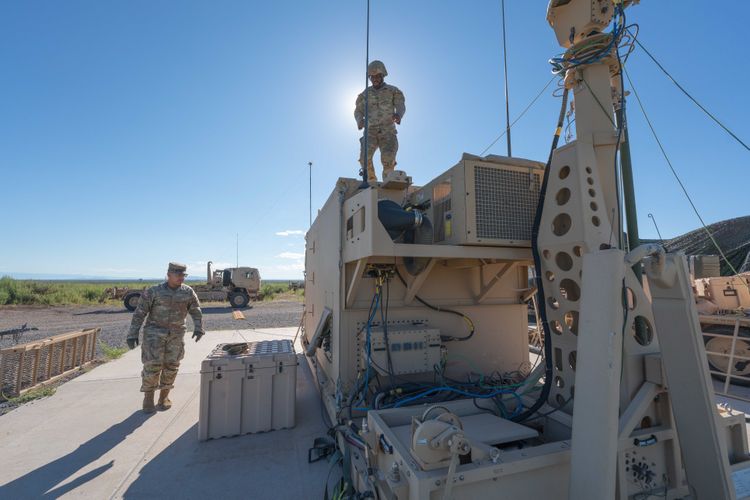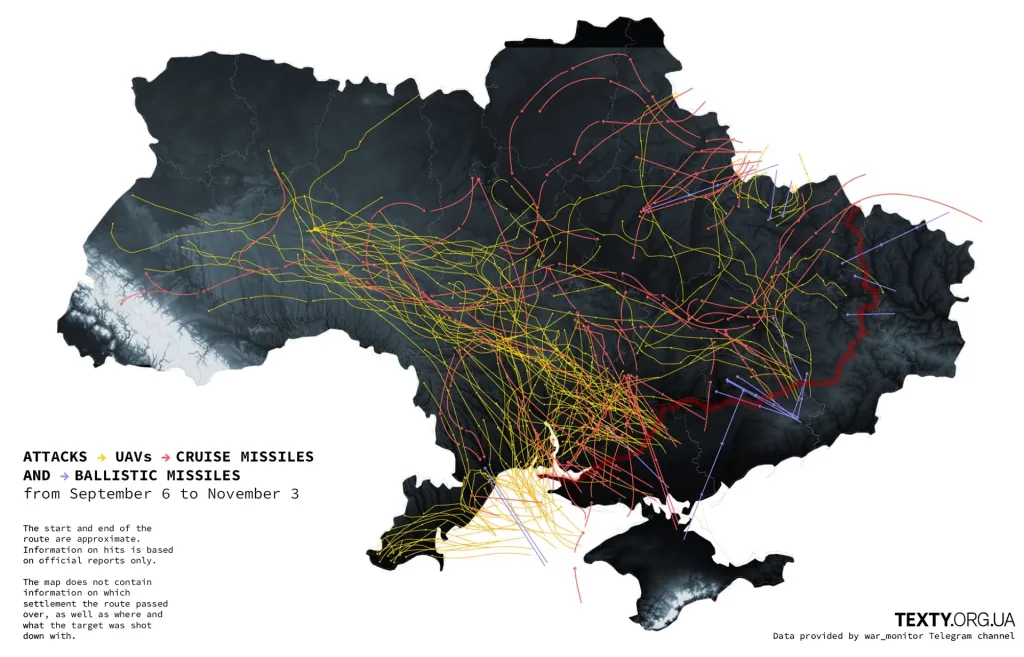IBCS integrates IFPC to defeat manoeuvring threat
The Integrated Battle Command System (IBCS) has integrated the US Army’s Indirect Fire Protection Capability (IFPC) and defeated drones and a surrogate cruise missile in a test at the White Sands missile range, according to a 9th December Northrop Grumman press release.
IBCS was used to detect and track two drones and a surrogate cruise missile before handing engagement protocols over to the IFPC during the test. With IBCS, “the U.S. Army can test emerging systems like IFPC that will help modernize air and missile defence,” Kenn Todorov, Northrop’s vice president and general manager, global battle management and readiness said in a statement.
As of April 2023, when the IBCS achieved Initial Operational Capability (IOC) and completed its integration with Patriot Command and Control (C2) systems, the IBCS has been cleared for full-rate production with plans for deployment to all U.S. Patriot Battalions. Additionally, the IBCS is fielded in Poland under WISLA, its air and missile defence program, with a planned deployment to Guam as part of the US military’s integrated air and missile defence modernisation.
As far as the IFPC is concerned, the programme actually dates back to 2004 which led to a brief dalliance with the Israeli Iron Dome, but difficulties integrating the system led to a change in direction from 2020. At which point the US Army awarded a contract to Dynetics, owned by Leidos, in September 2021 for the development and delivery of 16 IFPC launcher prototypes, 60 interceptors and all-up-round magazines.
This was followed on the 13th of November 2024, with an Undefinitized Indefinite Delivery/Indefinite Quantity letter contract valued at a maximum of $4.1 billion for low-rate initial production, full-rate production, and support services initially procuring a further 18 IFPC Increment 2 launchers. The not-to-exceed dollar value of the undefinitized contract order is $204 million, of which $99 million was obligated immediately. The Army plans to field the IFPC to Guam by 2027, which has led to a compressed development time frame, counterintuitively leading to delays in the testing and development cycle.
Tech Profile: IBCS

This image shows the Engagement Operations Center of an IBCS at the White Sands Missile Range. Credit: US Army.
The IBCS is a mission command fire-control system capable of unifying sensors and effectors across the battle space and creating a singular integrated actionable picture for militaries using network-enabled, modular, open, and scalable architecture. In simple terms, this means that the IBCS is able to integrate different sensors – like radars from the US Marine Corps and US Army – into a network allowing them to share data with each other.
While this may sound fairly banal in a world where you can connect your fridge to your phone, it is actually a really big deal for defence systems. The reason for this, at least in the air defence space, is that radars and missiles are typically built to work together. The AN/MPQ-53 radar at the heart of the MIM-104 Patriot, for example, is really only designed to work with the Patriot fire control section and M90- series missile launchers. It could be used to pass warnings onto other systems, but typically, targeting data from an MIM-104 battery could not be passed directly to another system like an F-35 in a form that the F-35 could immediately use. The IBCS is designed to address this by providing a bridge between systems so that targeting data from a USMC G/ATOR radar could be passed directly to a Patriot that then carries out an engagement. This enables air defence systems to be networked and make more effective matches between weapons and targets.
To do this, the IBCS, uses a “plug and fight” technology that integrates multi-domain sensors and effectors into its Integrated Fire Control Network (IFCN). An IFCN is a network which “enables the collaborative use of distributed warfare assets for time-critical operations”. By establishing an IFCN, the IBCS can defend 40% more assets with the same number of sensors and effectors, according to Northrop Grumman. As demonstrated in previous tests, IBCS is compatible with many sensors and effectors, including Patriot, Sentinel, F-35, Common Anti-Air Modular Missile, Giraffe, Lower Tier Air and Missile Defence Sensor (LTAMDS). Future plans for the IBCS include the integration of the Sentinel A4 Radar and the Terminal High-Altitude Air Defence (THAAD) system.
The IBCS comprises three key components: the Engagement Operations Centre (EOC) S-280 Shelter, the Integrated Collaborative Environment (ICE) and the IFCN Relay. The EOC is a mobile command and control (C2) centre where air and missile defence operations are carried out; the S-280 Shelter and ICE provide an overall capacity of 12-24 operators. Current U.S. Army plans are that IBCS will be deployed with 6 EOCs in a battalion alongside 12 IFCN Relays. Whilst plans are that the EOC are deployed in groups, each EOC functions independently, ensuring that if one or more are damaged, the overall system remains operational, a design which the current Patriot system lacks; if a Patriot EOC is damaged, then an entire battery can be affected. The IFCN Relay forms the IFCN, has a 30m antenna, uses radio, fibre optic and satellite systems and is responsible for all data transmission between sensors, effectors and the EOCs, enabling the execution of operations using the IBCS. The relay also contains the aforementioned “plug and fight” technology, which enables sensors and effectors to adapt to the IFCN. The relay is enabled by the Army’s Joint Track Management Capability Bridge and the Navy’s Cooperative Engagement Capability which enables data from different services to be shared.
Tech Profile: IFPC

The IFCS interceptor launcher is shown here. It was integrated into the IBCS during the Northrop test, showing that it could be networked other air defence systems. Credit: US Army.
The IFPC is a ground-based air defence system designed to protect critical stationary assets against cruise missile, unmanned aerial vehicle (UAV) and rocket, artillery and mortar (RAM) attacks. The system is intended to close the gap between short-range air defence, Patriot and THAAD. The latter two threat groups are often seen against US bases in Syria and Iraq, leading to kinetic strikes to protect the bases.
Three variants of the IFPC are currently under development: the Increment 2 Interceptor variant, the high energy laser variant and the High-Power Microwave (HPM) variant. The Interceptor incorporates modular open-systems architecture, allowing for direct integration with IBCS; currently, it has conducted intercept tests with the AIM-9X Sidewinder missile against UAVs and cruise missile test targets. According to the Congressional Research Service, the US Army intends to develop a second interceptor capable of targeting lower-flying supersonic CM, with the capability of the AIM-120D Advanced Medium Range Air-to-Air Missile, but with a larger magazine depth of 18 rounds, as opposed to the 6 rounds that the in-service NASAMS launcher can carry.
The high energy laser variant would operate a 300kW laser and reportedly be effective against RAM threats, UAVs, and rotary and fixed-wing targets. However, the laser variant may not proceed as its funding has been reduced within the IFPC programme and the Army is exploring a “buy-try-decide strategy” with the freed-up funds being directed to higher priority efforts.
Lastly, the HPM variant developed by Epirus would be effective against small UAVs, 27 kg or less, in swarm attack scenarios. It is listed as a Leonidas-derived counter-UAV swarm capability. The Leonidas system, as it is known, is a solid-state, high-power microwave system using Gallium Nitride semiconductors for counter-electronics effects. What does all this mean exactly? Solid state technology is an advance over vacuum tube technology used in older microwave devices. It means that the chips generating the microwave energy are built from solid materials – Gallium Nitride in this instance. GaN is valuable because it can handle very high levels of power, switch on and off very quickly, and is also very compact compared to alternative materials and solutions. So, in essence, the Leonidas is able to deliver vast amounts of energy to a drone very quickly and then switch to another target and repeat that process – imagine microwaving your phone and what that would do to the chips inside, and that is the effect that the system is designed to achieve.
Calibre Comment

This map from Texty.org.ua shows the routes taken by Russian missile strikes against Ukraine to complicate air defence. Systems like IBCS should in theory improve success rates against this kind of attack. Credit: Texty.org.ua https://texty.org.ua/articles/111259/air-war-routes-shahed-drones-and-missiles-during-september-october/
IBCS is the cornerstone of the US Army’s contribution to Joint All Domain Command and Control (JADC2) and efforts to integrate across domains and services – as well as with allies eventually. To that end, the IBCS is compatible with the MBDA’’s Common Anti-air Modular Missile (CAMM) system, as well as Saab’s Giraffe radar and Diehl’s IRIS-T SLM. Air defence is one use case that appears to show clear promise as far as multi-domain integration is concerned. Large scale attacks such as Iran’s missile strikes against Israel in April and October of this year are easier to counter with intelligence shared in real time between services and the response coordinated for optimal efficacy. Moreover, advanced missile strikes like those used by Russia against Ukraine will aim to stress and overwhelm an air defence network by flying very different variable routes and aiming to land multiple missiles from different directions simultaneously. Networking and coordinating sensors and effectors should, in theory, enable a more efficient response to these types of attack than is possible without automated coordination.
By Austin Haywood and Sam Cranny-Evans, published on 18th December, 2024.

Sign Up for Updates!
Get insider news, tips, and updates. No spam, just the good stuff!






